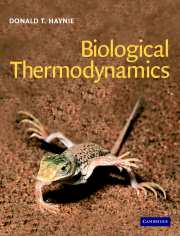Book contents
- Frontmatter
- Contents
- Preface
- Chapter 1 Energy transformation
- Chapter 2 The First Law of Thermodynamics
- Chapter 3 The Second Law of Thermodynamics
- Chapter 4 Gibbs free energy – theory
- Chapter 5 Gibbs free energy – applications
- Chapter 6 Statistical thermodynamics
- Chapter 7 Binding equilibria
- Chapter 8 Reaction kinetics
- Chapter 9 The frontier of biological thermodynamics
- Appendix A General references
- Appendix B Biocalorimetry
- Appendix C Useful tables
- Appendix D BASIC program for computing the intrinsic rate of amide hydrogen exchange from the backbone of a polypeptide
- Glossary
- Index of names
- Subject index
Chapter 5 - Gibbs free energy – applications
Published online by Cambridge University Press: 31 May 2010
- Frontmatter
- Contents
- Preface
- Chapter 1 Energy transformation
- Chapter 2 The First Law of Thermodynamics
- Chapter 3 The Second Law of Thermodynamics
- Chapter 4 Gibbs free energy – theory
- Chapter 5 Gibbs free energy – applications
- Chapter 6 Statistical thermodynamics
- Chapter 7 Binding equilibria
- Chapter 8 Reaction kinetics
- Chapter 9 The frontier of biological thermodynamics
- Appendix A General references
- Appendix B Biocalorimetry
- Appendix C Useful tables
- Appendix D BASIC program for computing the intrinsic rate of amide hydrogen exchange from the backbone of a polypeptide
- Glossary
- Index of names
- Subject index
Summary
Introduction
The Gibbs free energy is so important in biology research because it enables one to predict the direction of spontaneous change for a system under the constraints of constant temperature and pressure. These constraints generally apply to all living organisms. In the previous chapter we discussed basic properties of the Gibbs free energy, showed how its changes underlie a number of aspects of physical biochemistry, and touched on what the biological scientist might do with such knowledge. Here we build on that introduction to the basics and show how the elementary concepts can be applied to a wide variety of topics that are specifically biological or biochemical. We wish to illustrate, by way of a range of examples, when, where, why, and how the Gibbs free energy is such a useful concept. We shall discuss the energetics of very different types of biological structure, including small organic molecules, membranes, nucleic acids and proteins. This will help to give a deeper sense of the relatedness of the seemingly very different topics one encounters in biochemistry.
Photosynthesis, glycolysis, and the citric acid cycle
This section is a ‘low-resolution lens’ on the energetics of photosynthesis, glycolysis, and the citric acid cycle. The details we shall omit are certainly important (entire books have been written on each subject!), but our main aim here is to consider biological energy in a global, qualitative way; to see ‘the big picture.’
- Type
- Chapter
- Information
- Biological Thermodynamics , pp. 119 - 184Publisher: Cambridge University PressPrint publication year: 2001



